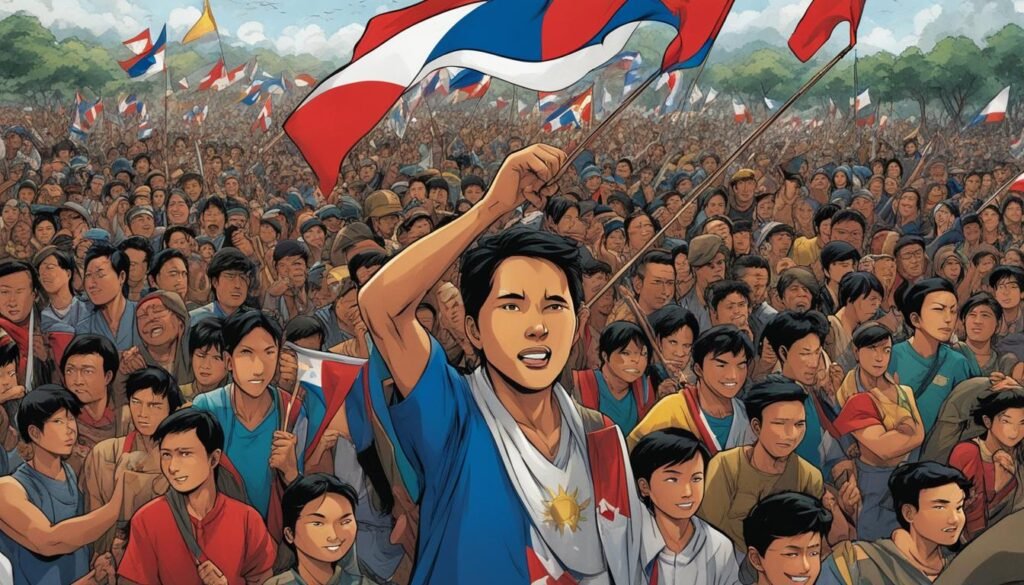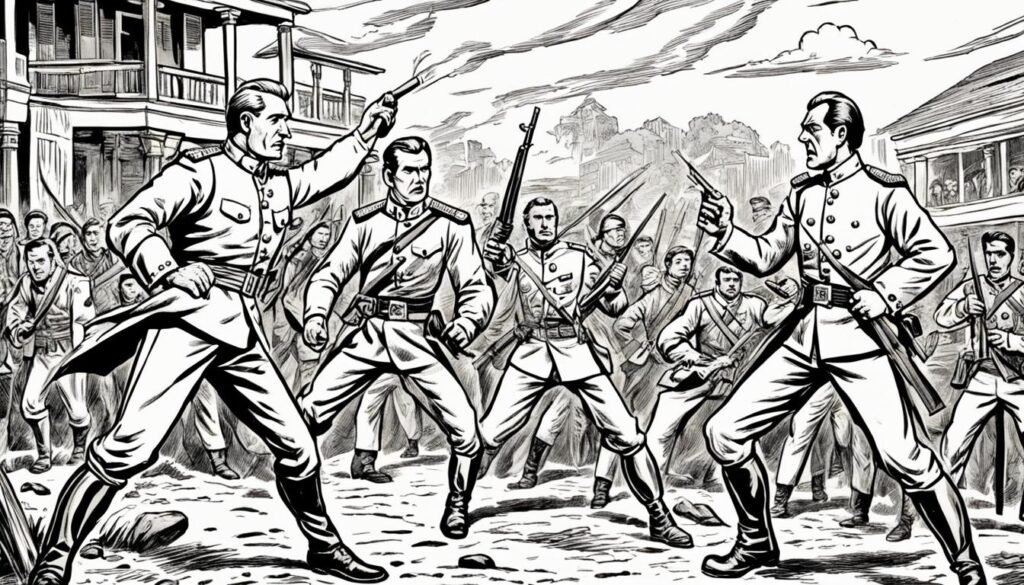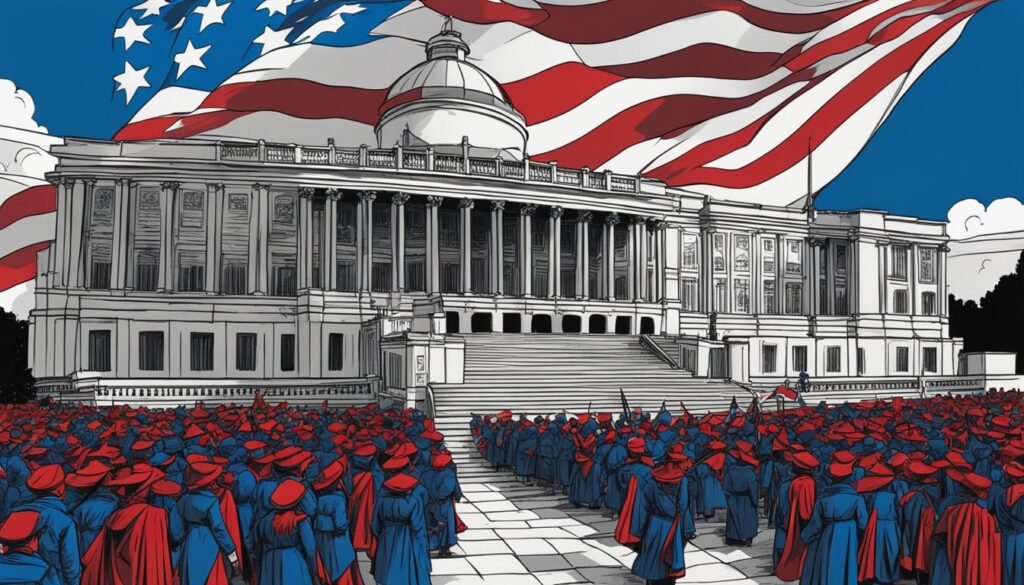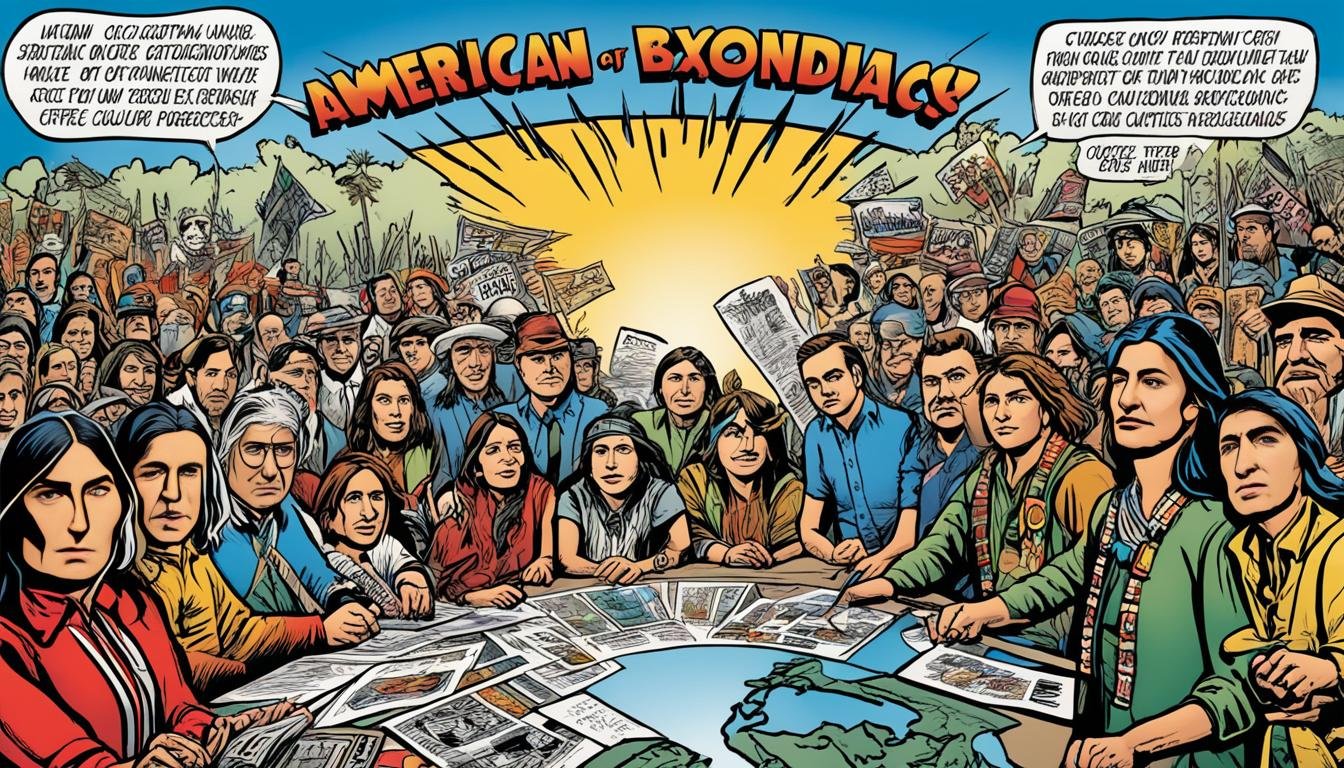Did you know that the policy of benevolent assimilation implemented by the United States in the Philippines eventually led to the eruption of the Philippine-American War? This surprising fact highlights the complex and far-reaching consequences of American colonial policy on the Philippine islands.
After the signing of the Treaty of Paris in 1898, the United States aimed to extend its military government over the ceded territory and win the confidence and respect of the Filipino people through the policy of benevolent assimilation. However, tensions and clashes of intentions between the desire for Philippine independence and American control fueled the outbreak of a war that would shape the course of Philippine history.
Key Takeaways:
- The policy of benevolent assimilation implemented by the United States in the Philippines led to the eruption of the Philippine-American War.
- The treaty of Paris in 1898 transferred control of the Philippine islands to the United States, setting the stage for American colonial policy.
- The clash between the Filipino desire for independence and the American policy of benevolent assimilation fueled the outbreak of the Philippine-American War.
- The proclamation of benevolent assimilation aimed to win the confidence, respect, and affection of the Filipino people while assuring their individual rights and liberties.
- The alterations made by General Elwell Otis to the original proclamation of benevolent assimilation sparked different interpretations and reactions to the policy.
Background of Benevolent Assimilation
The policy of Benevolent Assimilation was formulated and proclaimed by President William McKinley in December 1898 after the signing of the Treaty of Paris. This treaty ended the Spanish-American War and transferred control of the Philippine islands to the United States. The policy aimed to establish a US military government over the Philippines and assure the Filipino people of their individual rights and liberties. It was seen as a way to peacefully transition the Philippines from Spanish colonial rule to American control.
President William McKinley, with the support of the US Congress, implemented the policy of Benevolent Assimilation as a means to bring stability and prosperity to the Philippines. The Treaty of Paris, signed on December 10, 1898, formally ended the Spanish-American War and marked the transfer of control over the Philippines from Spain to the United States.
The policy of Benevolent Assimilation sought to establish a US military government in the Philippines, focusing on winning the Filipino people’s confidence and respect. President McKinley believed that by introducing American standards of justice, education, and infrastructure, the Philippines would experience significant progress and ultimately support US influence in the region.
“There must be no thought of any dismemberment of our sister Republic, but rather a recognition of her individuality and a determination to elevate her to a position which will enable her to take that place in the world that God intended she should occupy.”
President McKinley’s policy of Benevolent Assimilation aimed to create a harmonious relationship with the Philippines and ensure their individual rights and liberties. The policy was driven not only by strategic geopolitical interests but also by a belief in the moral responsibility of the United States to guide and uplift the Filipino people.
Signed Treaty, Promised Assimilation
The Treaty of Paris, signed in 1898, formally transferred control of the Philippines from Spain to the United States. It marked a significant turning point in Philippine history, as the country transitioned from Spanish colonial rule to American control. The treaty also set the stage for the implementation of the Benevolent Assimilation policy.
Under the terms of the Treaty of Paris, the United States paid Spain $20 million in exchange for Spain’s cession of the Philippines, Puerto Rico, and Guam to America. The Philippines, in particular, became the focus of US attention as an opportunity to expand American influence in the Asia-Pacific region.
The Treaty of Paris also compelled the United States to extend the benefits of “a liberal government” to the people of the Philippines. It further pledged the United States to improve the condition of the people, protect their rights and liberty, and aid in the speedy development of “self-governing institutions.”
“The civil rights and political status of the native inhabitants of the territories hereby ceded to the United States shall be determined by the Congress.”
This clause from the treaty laid the foundation for the implementation of the Benevolent Assimilation policy, as it empowered the US Congress to determine the political and civil rights of the Filipino people. The United States saw this as an opportunity to guide the Philippines towards self-governance and eventually independence. However, the route towards Philippine independence proved to be complex, with conflicting intentions and aspirations between the United States and the Filipino people.
Clash of Intentions: Philippines’ Declaration of Independence
Six months before the proclamation of benevolent assimilation, Emilio Aguinaldo boldly declared the Philippines as a free and independent nation, establishing a revolutionary government. This historic declaration was a significant milestone in the Filipino people’s quest for self-determination and autonomy.
Aguinaldo’s proclamation sparked a clash of intentions between the Filipino desire for independence and the American policy of benevolent assimilation. As tensions heightened, the Filipino revolutionary armed forces surrounded the American forces in Manila, leading to a tense standoff and the eventual outbreak of the Philippine-American War.
The Philippine-American War, which lasted from 1899 to 1902, witnessed fierce battles and significant loss of life on both sides. It was a result of the conflicting aspirations for independence and American efforts to assert control over the Philippines.
The clash of intentions between the Filipino people and the American government laid the foundation for one of the most tumultuous periods in Philippine history. It was a struggle that embodied the fight for Philippine independence and set the stage for the enduring resilience and determination of the Filipino people.
“The Filipino people, imploring the aid of Divine Providence and desiring to lead a free and independent existence, do hereby proclaim and declare a revolutionary government…” – Emilio Aguinaldo
The proclamation of the revolutionary government by Emilio Aguinaldo marked a turning point in the Filipino fight for independence. It symbolized their steadfast determination to achieve self-rule and challenged the American policy of benevolent assimilation.
This clash of intentions would shape the course of the Philippine-American War and pave the way for a protracted struggle for freedom and sovereignty.

| Key Figures | Events |
|---|---|
| Emilio Aguinaldo | Declaration of the revolutionary government |
| Philippine revolutionary armed forces | Surrounding American forces in Manila |
| Standoff | Between Filipino and American forces |
| Philippine-American War | Outbreak and consequences |
The Content of the Proclamation
The proclamation of benevolent assimilation underscored the unwavering commitment of the US military administration to cultivate the confidence, respect, and affection of the Filipino people. It aimed to affirm and guarantee their individual rights and liberties, fostering a society that upholds justice and the rule of law, unyielding to arbitrary rule. The proclamation served as a cornerstone in establishing a sense of trust and goodwill between the American authorities and the Filipino population, paving the way for a harmonious coexistence.
Reactions and Modifications of the Proclamation
General Elwell Otis, the US military commander in the Philippines, played a significant role in shaping the proclamation of benevolent assimilation. Before sending it to Emilio Aguinaldo, Otis made alterations to the original version of the proclamation. His modifications aimed to avoid offending Filipino sensibilities and create a more favorable impression of the United States.
Removing any mention of US sovereignty, General Otis sought to present the policy as a cooperative effort rather than an imposition. He also replaced certain terms with milder alternatives to address concerns of unequal power dynamics and foster a sense of unity and mutual respect between the Americans and the Filipinos.
However, despite Otis’ alterations, an unaltered version of the proclamation reached Emilio Aguinaldo through another source. This discrepancy highlighted the differing interpretations and reactions to the policy, further fueling the tensions between the American military and the Filipino revolutionary forces.

The altered and unaltered versions of the proclamation exemplify the complexities surrounding the implementation of the benevolent assimilation policy. This episode underscores the struggle for understanding and negotiation between the American authorities and the Filipino leaders, shedding light on the conflicting perspectives and interests that shaped the course of history in the Philippines.
Criticisms and Implications of Benevolent Assimilation
Benevolent assimilation, despite its intended image of goodwill, has faced significant criticism and raised important implications. Many perceive it as a form of colonialism and racism due to the US control it imposed over the Philippines. The clash between Filipino revolutionaries and the presence of the US military further fueled these criticisms, prompting questions about the true intentions of benevolent assimilation.
“Benevolent assimilation, presented as a benevolent act, conceals the underlying agenda of colonial control and the perpetuation of racial superiority.”
The policy of benevolent assimilation allowed the United States to extend its dominion over the Philippines, perpetuating the legacy of colonialism. This control and influence exerted through benevolent assimilation reflects underlying racist ideologies and power dynamics. The conflict between Filipino revolutionaries and the US military presence during this period ultimately led to a prolonged and devastating war.
It is essential to critically examine the implications of benevolent assimilation, as it illuminates the complex dynamics between the colonizer and the colonized, as well as the lasting effects of US military presence.
Impact of Colonialism
The policy of benevolent assimilation exemplifies the neocolonialist approach adopted by the United States towards the Philippines. While presenting itself as a benevolent force, the US government exploited the country for its resources and strategic advantage. This exploitative nature echoes the dark history of colonialism, perpetuating economic inequality and socio-cultural supremacy.
Filipino Revolutionaries and the Struggle for Independence
The clash between Filipino revolutionaries and the US military presence reveals the fierce determination and resistance of the Filipino people against foreign control. Throughout the Philippine-American War, Filipino revolutionaries fought bravely to defend their independence and sovereignty, challenging the narrative of benevolent assimilation.
Table:
| Colonialism and Racism in Benevolent Assimilation | Implications for Philippine Society |
|---|---|
| The policy allowed for US control under the facade of benevolence | Challenged the notion of self-determination and perpetuated external domination |
| Benevolent assimilation masked the racist ideologies underlying US expansionism | Contributed to the perpetuation of racial superiority and devalued Filipino identity |
| The clash between Filipino revolutionaries and US military presence highlighted resistance against foreign control | Inspired a strong sense of nationalism and the pursuit of true independence |
This table outlines the colonialist and racist nature of benevolent assimilation, as well as its implications for Philippine society. It emphasizes the contradictions and long-lasting impact of this policy.
Understanding the criticisms and implications of benevolent assimilation sheds light on the complexities of colonial history and its lingering effects. By critically examining this chapter, we can strive for a more comprehensive understanding of the Filipino struggle for independence and the ongoing pursuit of self-determination.
Charter Change as a Reflection of Benevolent Assimilation
The influence of benevolent assimilation can still be seen today in the Philippines’ political system. The presidential system, derived from American colonial rule, has been critiqued for perpetuating neocolonialism and elitism. Proponents of charter change argue that transitioning to a parliamentary government would help break away from the colonial legacy and promote true democratization.
The Presidential System: Perpetuating Neocolonialism and Elitism
The establishment of the presidential system in the Philippines, modeled after the American political structure, has drawn criticism for perpetuating neocolonialism and reinforcing elitism. This system concentrates power in the hands of a single individual, the president, which can lead to a concentration of power and limited checks and balances. Critics argue that this system enables the perpetuation of neocolonial dynamics, where the ruling elite maintain control while the majority of the population is marginalized.
In a presidential system, the president is often seen as the embodiment of power, with significant discretion over policy decisions. This concentration of power can lead to a sense of detachment and lack of accountability. Furthermore, the presidential system tends to favor the interests of the elite, as those with access to resources and networks can gain an advantage in the electoral process.
Charter Change: Transitioning Towards a Parliamentary Government
Advocates for charter change argue that transitioning to a parliamentary government would address the shortcomings of the presidential system and promote true democratization. A parliamentary system distributes power among multiple elected representatives and allows for greater checks and balances. This system promotes consensus-building and ensures that decisions are made collectively, rather than being solely dependent on the actions of one individual.
By transitioning to a parliamentary government, the Philippines can break away from the colonial legacy of benevolent assimilation and forge a more inclusive and participatory democratic government. A parliamentary system encourages broader representation and allows for the voices of different sectors and regions to be heard. This can lead to a more equitable distribution of power and resources, promoting social justice and reducing elitism.
Overall, charter change represents an opportunity for the Philippines to redefine its political landscape and move away from the remnants of benevolent assimilation. By transitioning to a parliamentary system, the country can work towards a more democratic and inclusive society, breaking free from neocolonial tendencies and promoting the ideals of self-determination and equal representation.
| Presidential System | Parliamentary System |
|---|---|
| Concentration of power in the hands of the president | Distribution of power among elected representatives |
| Limited checks and balances | Greater checks and balances |
| Potential perpetuation of neocolonial dynamics | Promotion of inclusivity and equal representation |
| Reinforcement of elitism | Promotion of social justice |
Table: A Comparison of the Presidential and Parliamentary Systems
A comparison between the presidential and parliamentary systems underscores the potential benefits of charter change. Transitioning to a parliamentary government would foster a more balanced distribution of power and ensure greater accountability. With its focus on consensus-building and inclusive representation, a parliamentary system can help the Philippines move beyond the legacy of benevolent assimilation and build a more robust and participatory democracy.

Conclusion
The policy of benevolent assimilation had a profound impact on the history and political landscape of the Philippines. The struggles and conflicts arising from this policy still resonate today. However, the call for charter change signifies a determined effort to reclaim independence and shape the destiny of the nation, breaking free from the colonial hold of the past. The transition towards a parliamentary government can be regarded as a revolutionary step towards genuine self-determination.
The colonial hold imposed by benevolent assimilation shaped the course of Philippine history, influencing the relationship between the Filipino people and the governing regime. The desire for a shifting government that truly reflects the aspirations of the nation has always been intertwined with the fight for independence and revolution.
By advocating for charter change, the Filipino people present a vision of their national destiny and challenge the remnants of benevolent assimilation. This shift towards a parliamentary system represents a progressive departure from the past, as it gives more power and voice to the people, promoting a more inclusive and democratic approach to governance. The quest for true independence and self-determination is a continued struggle that defines the Philippine destiny and paves the way for a brighter future.
FAQ
What was the purpose of the policy of benevolent assimilation?
The policy of benevolent assimilation aimed to extend US military government over the Philippines and win the confidence and respect of the Filipino people.
Who formulated and proclaimed the policy of benevolent assimilation?
President William McKinley formulated and proclaimed the policy of benevolent assimilation in December 1898 after the signing of the Treaty of Paris.
What led to the outbreak of the Philippine-American War?
The clash of intentions between the Filipino desire for independence and the American policy of benevolent assimilation fueled the conflict, which eventually led to the eruption of the Philippine-American War.
What did the proclamation of benevolent assimilation emphasize?
The proclamation of benevolent assimilation emphasized the intention of the US military administration to win the confidence, respect, and affection of the Filipino people and assure them of their individual rights and liberties.
How did General Elwell Otis modify the proclamation of benevolent assimilation?
General Elwell Otis altered the original proclamation before sending it to Emilio Aguinaldo. He removed mentions of US sovereignty and replaced certain terms with milder alternatives to avoid offending Filipino sensibilities.
What criticisms have been raised about benevolent assimilation?
Some view benevolent assimilation as a form of colonialism and racism since it allowed for US control over the Philippines while presenting the image of benevolence.
How does the idea of charter change reflect the impact of benevolent assimilation?
Proponents of charter change argue that transitioning to a parliamentary government would help break away from the colonial legacy and promote true democratization, challenging the remnants of benevolent assimilation.
What is the ongoing legacy of benevolent assimilation in the Philippines?
The conflict and tensions associated with benevolent assimilation continue to be felt today. The advocacy for shifting to a parliamentary government reflects a desire to reclaim independence and shape the country’s destiny free from the colonial hold of the past.
Source Links
- https://en.wikipedia.org/wiki/Benevolent_assimilation
- https://www.niu.edu/clas/cseas/_pdf/lesson-plans/fulbright-hays/philippine-american-war-mini.pdf
- https://www.philstar.com/opinion/2009/02/15/440187/benevolent-assimilation

